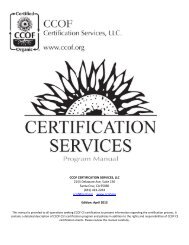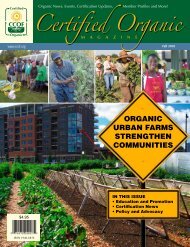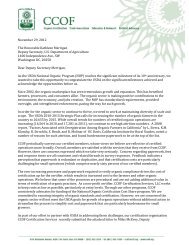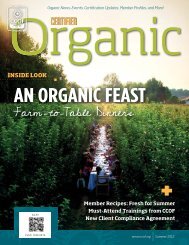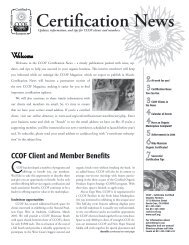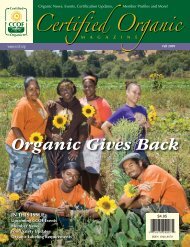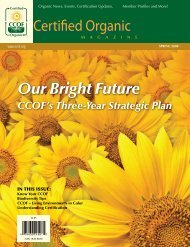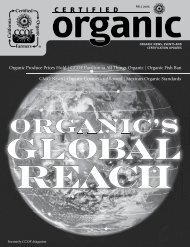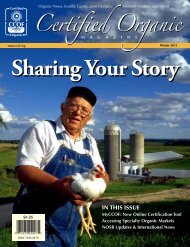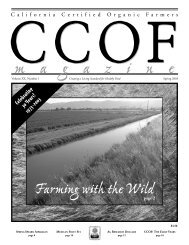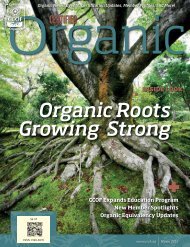Going Organic: Training New Growers - CCOF
Going Organic: Training New Growers - CCOF
Going Organic: Training New Growers - CCOF
You also want an ePaper? Increase the reach of your titles
YUMPU automatically turns print PDFs into web optimized ePapers that Google loves.
Clockwise from top left: 1) Ed Sills of<br />
Pleasant Grove Farms (left), and <strong>Going</strong> <strong>Organic</strong><br />
Management Team member Greg House<br />
of Coco Ranch. 2) Carl Rosato, <strong>CCOF</strong> archive photo.<br />
3) <strong>Going</strong> <strong>Organic</strong> will research organic and non-organic<br />
farm water quality. 4) Phil LaRocca.<br />
ing techniques. Deb Conway from the Butte College Farm<br />
appreciated learning about irrigation, trellis systems, and<br />
composting from her mentor, Phil LaRocca, <strong>CCOF</strong> Foundation<br />
Vice Chair and past <strong>CCOF</strong> President, during her farm<br />
visit to his Forest Ranch vineyard.<br />
Expanding the Program to the Whole Valley<br />
The <strong>CCOF</strong> Foundation then leveraged information<br />
gained during <strong>Going</strong> <strong>Organic</strong>’s pilot year in its application<br />
for an Agricultural Water Quality Grant program. In March<br />
2005, the California State Water Resources Control Board<br />
(Water Board) approved a $650,000 grant to expand the <strong>Going</strong><br />
<strong>Organic</strong> program throughout the entire Central Valley<br />
watershed. <strong>CCOF</strong>’s Yolo, Sierra-Gold, Big Valley and Kern<br />
Chapters will now join the three pilot chapters. The new<br />
three-year grant will fund 25 mentors helping 40 organic<br />
trainees in the seven participating chapters. Goals include<br />
transition of 5000 acres to organic production, representing a<br />
5% increase in organic acreage in the project’s area.<br />
As before, informational meetings and seminars will help<br />
non-organic farmers learn organic practices and overcome<br />
barriers identified in the pilot study. These events will be<br />
Goals include transition of 5000 acres to organic<br />
production, representing a 5% increase in<br />
organic acreage in the project’s area.<br />
held in the seven chapters over a three-year period and will<br />
address compost, cover crops, weed control, erosion control,<br />
organic certification, and application for government<br />
cost-share programs. A new crop of trainees will learn from<br />
experienced organic farmers how to be sustainable and successful.<br />
A new aspect of the project will include a scientific<br />
assessment of organic watersheds to guide future Water<br />
Board programs.<br />
Water Board-funded projects aim at reducing the discharge<br />
of non-point source toxicants into the Central Valley<br />
watershed. Expected results of the expanded <strong>Going</strong> <strong>Organic</strong><br />
program include improved water quality. As part of the<br />
progect water quality and economic viability studies will be<br />
conducted on organic and non-organic systems. Long-term<br />
organic and non-organic farm watersheds will be compared<br />
for health, sedimentation, pesticide contamination, economic<br />
sustainability, and water quality. The findings will be<br />
useful to <strong>CCOF</strong>, organic farmers, the farming community,<br />
<strong>Going</strong> <strong>Organic</strong> continued on page 20<br />
Winter 2006 Certified <strong>Organic</strong> 1



